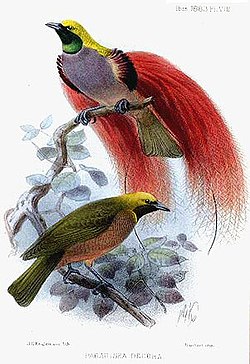| Goldie's bird-of-paradise | |
|---|---|
 | |
| Illustration of male (above) and female (below) | |
| Scientific classification | |
| Domain: | Eukaryota |
| Kingdom: | Animalia |
| Phylum: | Chordata |
| Class: | Aves |
| Order: | Passeriformes |
| Family: | Paradisaeidae |
| Genus: | Paradisaea |
| Species: | P. decora |
| Binomial name | |
| Paradisaea decora | |
Goldie's bird-of-paradise (Paradisaea decora) is a species of bird-of-paradise.
Contents
Endemic to Papua New Guinea, the Goldie's bird-of-paradise is distributed in the hill forests of Fergusson and Normanby Island of the D'Entrecasteaux Archipelago, eastern Papuan Islands. The diet consists mainly of fruits.
The name commemorates the Scottish collector Andrew Goldie, who discovered the bird in 1882.
Due to ongoing habitat loss, limited range and overhunting in some areas, the Goldie's bird-of-paradise is evaluated as Vulnerable on the IUCN Red List of Threatened Species. It is listed on Appendix II of CITES.
